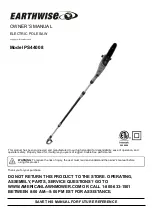
6
19. Place the wider portion of the saw base on that
part of the workpiece which is solidly supported,
not on the section that will fall off when the cut is
made. As examples, Fig. A illustrates the RIGHT
way to cut off the end of a board, and Fig. B the
WRONG way. If the workpiece is short or small,
clamp it down. DO NOT TRY TO HOLD SHORT
PIECES BY HAND!
Fig. A
Fig. B
20. Before setting the tool down after completing a
cut, be sure that the lower guard has closed and
the blade has come to a complete stop.
21. Never attempt to saw with the circular saw held
upside down in a vise. This is extremely
dangerous and can lead to serious accidents.
22. Some material contains chemicals which may be
toxic. Take caution to prevent dust inhalation
and skin contact. Follow material supplier safety
data.
23. Do not stop the blades by lateral pressure on the
saw blade.
24. Always use blades recommended in this manual.
Do not use any abrasive wheels.
25. Keep blade sharp and clean.
Gum and wood pitch
hardened on blades slows saw and increases
potential for kickback. Keep blade clean by first
removing it from tool, then cleaning it with gum and
pitch remover, hot water or kerosene. Never use
gasoline.
26. Wear a dust mask and hearing protection when
use the tool.
SAVE THESE INSTRUCTIONS.
WARNING:
DO NOT let comfort or familiarity with product
(gained from repeated use) replace strict adherence
to safety rules for the subject product. MISUSE or
failure to follow the safety rules stated in this instruc-
tion manual may cause serious personal injury.
FUNCTIONAL DESCRIPTION
CAUTION:
• Always be sure that the tool is switched off and
unplugged before adjusting or checking function on the
tool.
Adjusting depth of cut (Fig. 1)
CAUTION:
• After adjusting the depth of cut, always tighten the lever
securely.
Loosen the lever on the depth guide and move the base
up or down. At the desired depth of cut, secure the base
by tightening the lever.
For cleaner, safer cuts, set cut depth so that no more
than one blade tooth projects below workpiece. Using
proper cut depth helps to reduce potential for dangerous
KICKBACKS which can cause personal injury.
Bevel cutting (Fig. 2 & 3)
Setting bevel angle
Loosen the clamping nuts in front and back, and tilt the
tool to the desired angle for bevel cuts (0° – 45°). Secure
the clamping screws tightly in front and back after making
the adjustment.
Sighting (Fig. 4)
For straight cuts, align the A position on the front of the
base with your cutting line. For 45° bevel cuts, align the B
position with it.
Switch action (Fig. 5)
CAUTION:
• Before plugging in the tool, always check to see that
the switch trigger actuates properly and returns to the
“OFF” position when released.
To prevent the switch trigger from being accidentally
pulled, a lock-off button is provided. To start the tool,
push in the lock-off button and pull the switch trigger.
Release the switch trigger to stop.
For Model 5104S only
Soft start because of suppressed starting shock.
ASSEMBLY
CAUTION:
• Always be sure that the tool is switched off and
unplugged before carrying out any work on the tool.







































